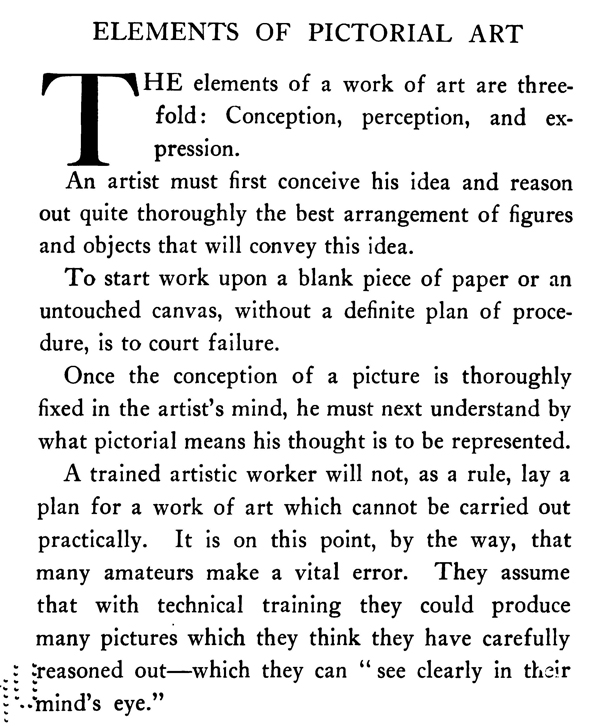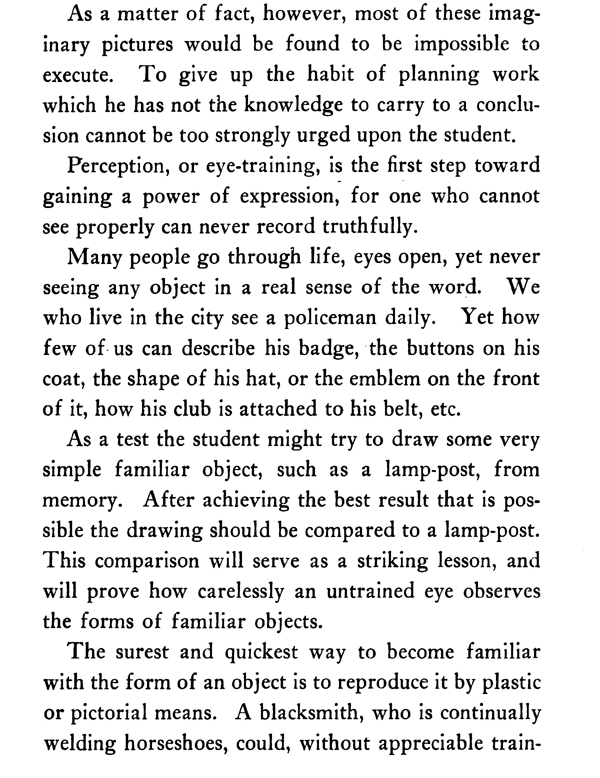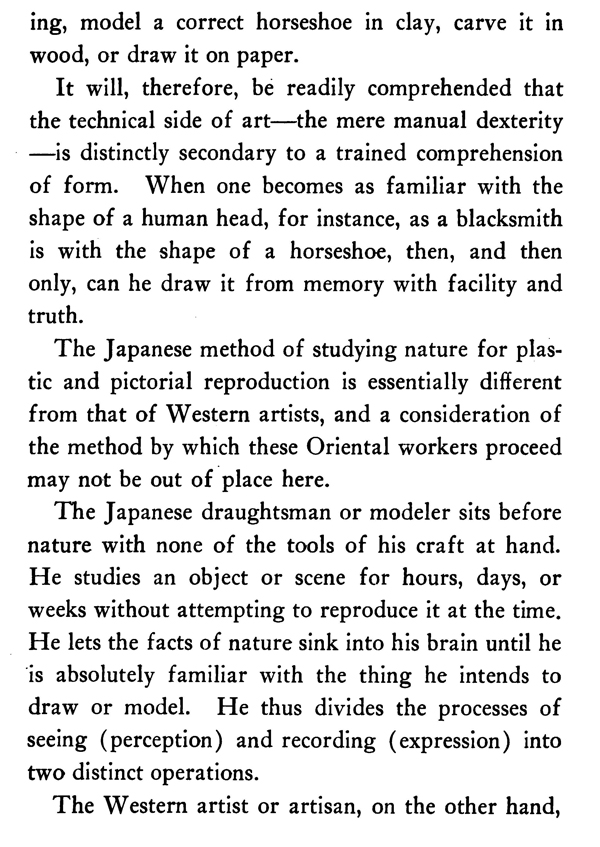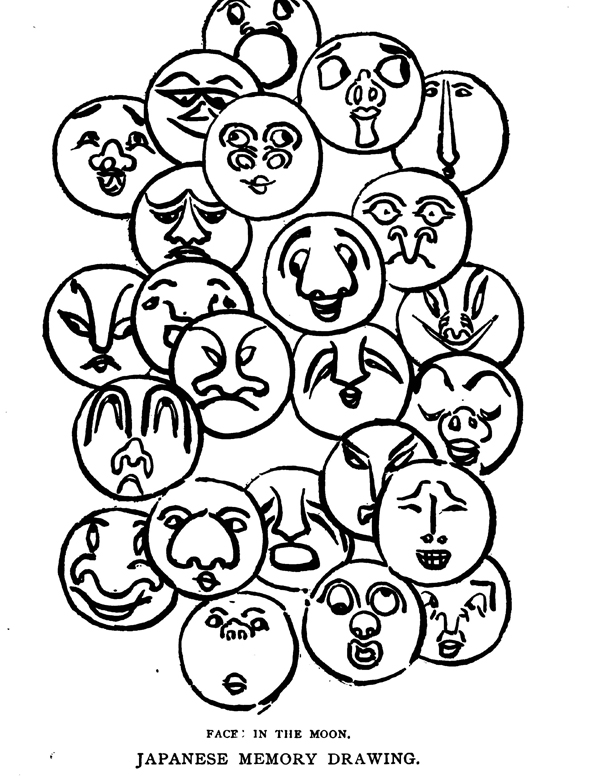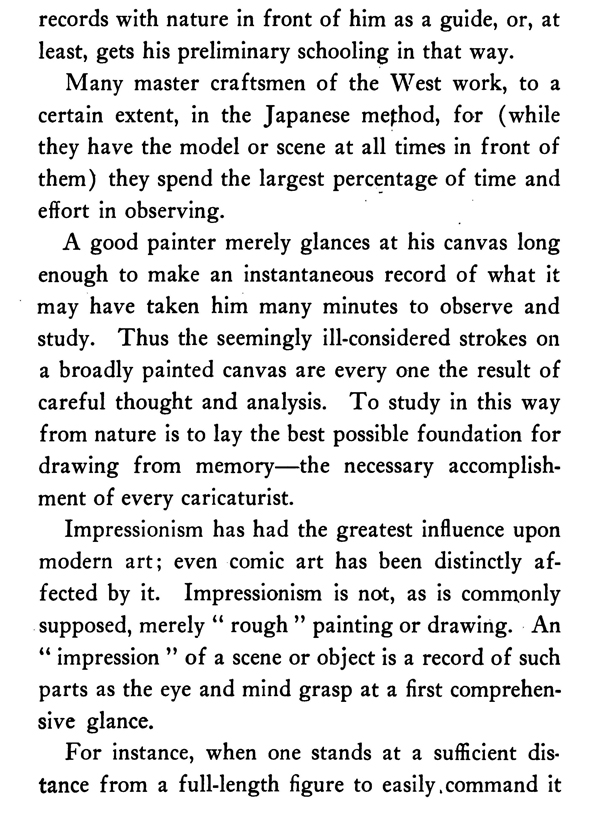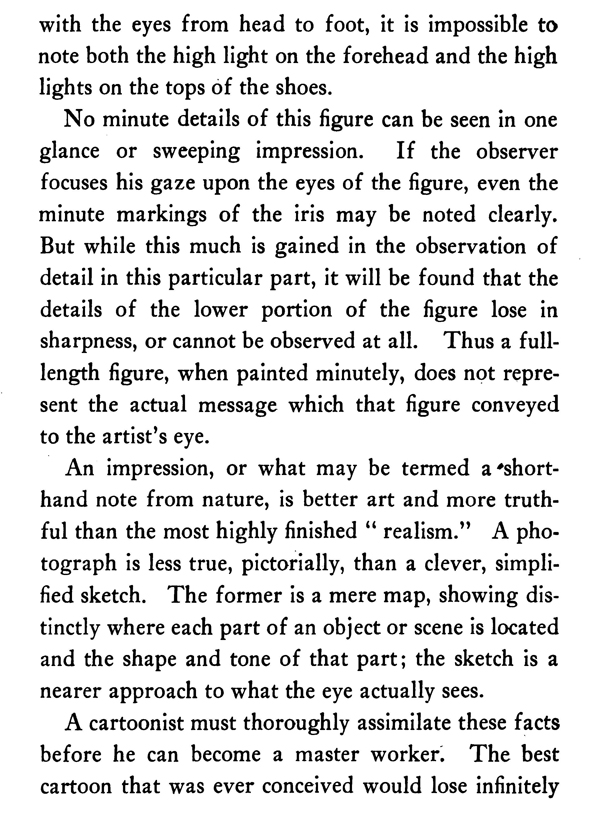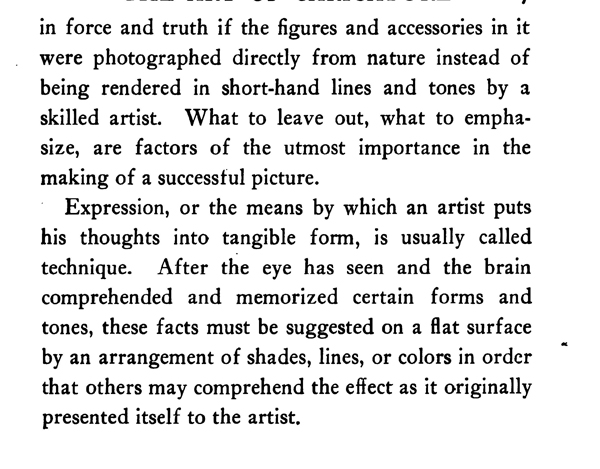Home > Directory Home > Drawing Lessons > How to Draw Caricatures & Cartoon Faces > Elements of Pictorial Art and Storytelling with Drawings
ELEMENTS OF PICTORIAL ART AND STORYTELLING WITH PICTURES AND DRAWINGS
|
GO BACK TO THE HOME PAGE FOR CARICATURE DRAWING TUTORIALS
[The above words are pictures of text, below is the actual text if you need to copy a paragraph or two]
ELEMENTS OF PICTORIAL ART
The elements of a work of art are threefold: Conception, perception, and expression. An artist must first conceive his idea and reason out quite thoroughly the best arrangement of figures and objects that will convey this idea.
To start work upon a blank piece of paper or an untouched canvas, without a definite plan of procedure, is to court failure. Once the conception of a picture is thoroughly fixed in the artist's mind, he must next understand by what pictorial means his thought is to be represented.
A trained artistic worker will not, as a rule, lay a plan for a work of art which cannot be carried out practically. It is on this point, by the way, that many amateurs make a vital error. They assume that with technical training they could produce many pictures which they think they have carefully ;reasoned out—which they can " see clearly in their "Mind's eye."
As a matter of fact, however, most of these imaginary pictures would be found to be impossible to execute. To give up the habit of planning work which he has not the knowledge to carry to a conclusion cannot be too strongly urged upon the student. Perception, or eye-training, is the first step toward gaining a power of expression, for one who cannot see properly can never record truthfully.
Many people go through life, eyes open, yet never seeing any object in a real sense of the word. We who live in the city see a policeman daily. Yet how few of us can describe his badge, the buttons on his coat, the shape of his hat, or the emblem on the front of it, how his club is attached to his belt, etc.
As a test the student might try to draw some very simple familiar object, such as a lamp-post, from memory. After achieving the best result that is possible the drawing should be compared to a lamp-post. This comparison will serve as a striking lesson, and will prove how carelessly an untrained eye observes the forms of familiar objects.
The surest and quickest way to become familiar with the form of an object is to reproduce it by plastic or pictorial means. A blacksmith, who is continually welding horseshoes, could, without appreciable train- ing, model a correct horseshoe in clay, carve it in wood, or draw it on paper.
It will, therefore, be readily comprehended that the technical side of art—the mere manual dexterity —is distinctly secondary to a trained comprehension of form. When one becomes as familiar with the shape of a human head, for instance, as a blacksmith is with the shape of a horseshoe, then, and then only, can he draw it from memory with facility and truth. The Japanese method of studying nature for plastic and pictorial reproduction is essentially different from that of Western artists, and a consideration of the method by which these Oriental workers proceed may not be out of place here. The Japanese draughtsman or modeler sits before nature with none of the tools of his craft at hand. He studies an object or scene for hours, days, or weeks without attempting to reproduce it at the time. He lets the facts of nature sink into his brain until he is absolutely familiar with the thing he intends to draw or model. He thus divides the processes of seeing (perception) and recording (expression) into two distinct operations.The Western artist or artisan, on the other hand,
JAPANESE MEMORY DRAWING.
records with nature in front of him as a guide, or, at least, gets his preliminary schooling in that way. Many master craftsmen of the West work, to a certain extent, in the Japanese method, for (while they have the model or scene at all times in front of them) they spend the largest percentage of time and effort in observing. A good painter merely glances at his canvas long enough to make an instantaneous record of what it may have taken him many minutes to observe and study. Thus the seemingly ill-considered strokes on a broadly painted canvas are every one the result of careful thought and analysis. To study in this way from nature is to lay the best possible foundation for drawing from memory—the necessary accomplishment of every caricaturist.
Impressionism has had the greatest influence upon modern art; even comic art has been distinctly affected by it. Impressionism is not, as is commonly supposed, merely " rough " painting or drawing. An " impression " of a scene or object is a record of such parts as the eye and mind grasp at a first comprehensive glance.For instance, when one stands at a sufficient distance from a full-length figure to easily ,command it
AN IMPRESSION, OR SHORTHAND NOTE FROM NATURE.
with the eyes from head to foot, it is impossible to note both the high light on the forehead and the high lights on the tops of the shoes.
No minute details of this figure can be seen in one glance or sweeping impression. If the observer focuses his gaze upon the eyes of the figure, even the minute markings of the iris may be noted clearly. But while this much is gained in the observation of detail in this particular part, it will be found that the details of the lower portion of the figure lose in sharpness, or cannot be observed at all. Thus a full-length figure, when painted minutely, does not represent the actual message which that figure conveyed to the artist's eye.
An impression, or what may be termed a •shorthand note from nature, is better art and more truthful than the most highly finished " realism." A photograph is less true, pictorially, than a clever, simplified sketch. The former is a mere map, showing distinctly where each part of an object or scene is located and the shape and tone of that part; the sketch is a nearer approach to what the eye actually sees.
A cartoonist must thoroughly assimilate these facts before he can become a master worker. The best cartoon that was ever conceived would lose infinitely in force and truth if the figures and accessories in it were photographed directly from nature instead of being rendered in short-hand lines and tones by a skilled artist. What to leave out, what to emphasize, are factors of the utmost importance in the making of a successful picture.
Expression, or the means by which an artist puts his thoughts into tangible form, is usually called technique. After the eye has seen and the brain comprehended and memorized certain forms and tones, these facts must be suggested on a flat surface by an arrangement of shades, lines, or colors in order that others may comprehend the effect as it originally presented itself to the artist.
Privacy Policy .... Contact Us





